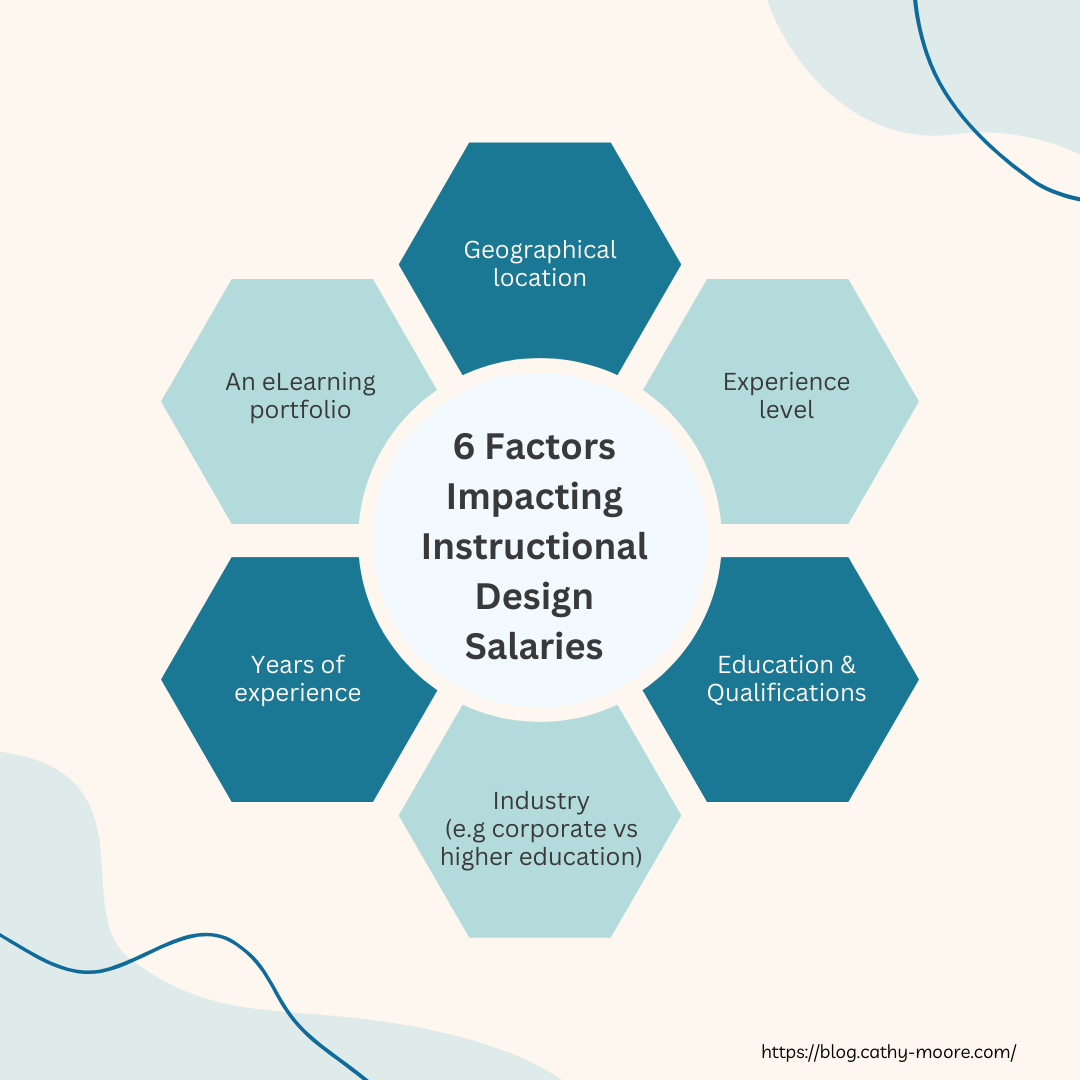Experts estimate the global elearning market will hit $282 billion by 2030, meaning instructional designers are in high demand. Indeed, a recent report by Devlin Peck revealed that US-based instructional designers with 0–3 years of experience have enjoyed an 8% salary increase in the past three years [1][2].
These statistics spell good news if you’re interested in pursuing a career in instructional design or if you’re already in the industry and looking to negotiate your salary.
There’s never been a more lucrative time to work in learning and development.
However, many fledgling instructional design professionals struggle to understand their worth in the marketplace. As a result, they settle for being underpaid.
This guide is here to help. We cover the average instructional design salary in 2024 based on location, contract type, and experience.
Take a deep dive to discover:
- Different job roles in instructional design
- Average salaries for instructional design jobs in 2024
- Factors that impact salaries in the field
- Three tips for negotiating your salary
What is an instructional designer?
An instructional designer builds and evaluates digital learning experiences, such as online courses, quizzes, training videos, and interactive activities.
Professionals in this field can work in a corporate or academic setting, depending on their experience and preferences.
All professionals in the field must be able to set learning goals, apply instructional design models, and manage eLearning technologies.
Check out our ‘What is an Instructional Designer?’ guide for a detailed overview of this job role.
Overview of instructional design jobs by salary
Instructional design is a broad field, giving professionals plenty of diverse career routes to choose from.
In the table below, we’ve outlined eight of the most popular instructional design-related jobs, what they involve, and the average US salary for each one.
| Job Role | Role and Responsibilities | Average Annual Salary (US) |
| Instructional Designer | Design and develop instructional materials, courses, and assessments Collaborate with SMEs and stakeholders to align learning goals Apply instructional design principles and best practices Evaluate and optimize current training programs | Range: $71K-$106K US average: $86,796 Source: Glassdoor |
| Elearning Developer | Build eLearning lessons using tools and software Design and integrate multimedia assets to enhance learning experiences Apply learning design principles Collaborate with SMEs, L&D teams, and other stakeholders | Range: $74K-$116K US average: $92,058 Source: Glassdoor |
| Curriculum Developer | Design curriculum materials for educational programs Collaborate with educators and instructional designers to align curriculum with learning objectives and standards Organize curriculum materials Analyze and evaluate current curriculum content | Range: $66K-$103K US average: $82,467 Source: Glassdoor |
| Training Specialist | Define training needs by conducting a needs assessment Set learning objectives and align them with company KPIs Design and deliver training programs Measure training ROI and suggest improvements to better meet performance goals | Range: $58K-$90K US average: $72,431 Source: Glassdoor |
| Corporate Trainer | Design and implement training sessions for corporate employees Develop training materials to help employees meet business goals Design assessments to measure learning outcomes Provide learners with individual feedback and personalized action plans | Range: $53K-$87K US average: $67,755 Source: Glassdoor |
| Educational Consultant | Advise organizations on effective teaching methods based on experience Support curriculum development Develop instructional strategies for educational institutions or companies Offer high-level guidance on educational practices | Range: $60K-$97K US average: $76,227 Source: Glassdoor |
| Multimedia Specialist | Design and develop multimedia elements for eLearning, such as videos, graphics, and animations Collaborate with instructional designers and SMEs Apply instructional design principles Align multimedia assets with learning goals | Range: $50K-$80K US average: $63,377 Source: Glassdoor |
| LMS Administrator | Manage and maintain a learning platform Offer technical support to learners and admins Train people on how to use the LMS Control user accounts, course content, and system configurations for a seamless learning experience | Range: $61K-$91K US average: $74,390 Source: Glassdoor |
*Please note that salary figures can vary based on factors such as experience, location, industry, and employer.
Key factors affecting instructional designer salaries
As we already know, several factors can impact your instructional designer salary.
From industry to qualifications, we examine the key factors and how they affect the average salaries in the learning and development field.

Role
Instructional design professionals have the option to work as an employee in an organization or as a freelancer. This may impact their overall earning potential.
Interestingly, 79.4% of instructional designers are internal employees, and 10% are freelancers or contractors [2].
Generally speaking, you may earn slightly more as a freelancer or contractor. But, you must also weigh up the benefits of having a full-time work contract.
Location
As we’ve already mentioned, your location can affect your income as an L&D or eLearning professional.
Let’s compare the average instructional designer salary in different countries:
| Country | Average Annual Salary |
| Australia | AUD $90k–$105k (around USD $58,900–$68,750) |
| Canada | CAD $57K–$77K (around USD $42,100–$56,900) |
| United Kingdom | £30K–£42K (around USD $37,900–$53,100) |
| India | ₹5L–₹10L (around USD $6,000–$12,000) |
| Singapore | S$21k–S$135k (around USD $15,600–$100k) |
| Ireland | €39K–€60K (around USD $42,300–$65k) |
Industry
You can expect to see pretty significant variations in salary for instructional designers across different sectors.
For instance, corporate instructional designers tend to be the highest earners, making almost 25% more than those in the higher education space [2].
Following that, instructional designers in the government and healthcare industry can expect to earn more than those in non-profit sectors.
Education
Unsurprisingly, having a college degree can impact your earning potential as an instructional designer.
While no official qualifications are necessary to carve out a career in L&D, statistics from the Devlin Peck report reveal that they can boost earning power.
Indeed, those with a professional degree earn, on average, $88,000 compared to those with some college ($66,607).
Experience
Experience is one of the biggest factors affecting instructional designer salary potential. Unsurprisingly, you tend to earn more the longer you’ve been in the field.
Let’s compare how years of experience impact salary, according to the Devlin Peck report:
- 0–3 years of experience: $77,856
- 4–8 years of experience: $87,809
- 9–15 years of experience: $93,046
- 16–20 years of experience: $108,214
- 21–25 years of experience: $109,750
- 26+ years of experience: $95,583
Portfolio
We have good news. There is one factor that can boost your earning potential right away – an instructional design portfolio.
The Devlin Peck report reported that instructional designers with a portfolio earn around 7% more than those without one. This is especially true for professionals with less than three years of experience.
So, if you’re new to the field and want to increase our salary, invest in creating an eLearning portfolio.
Key tips for negotiating your salary as an instructional designer
Location and industry experience may play a large part in your salary, but your negotiation skills can also be a contributor.
Learning your value in the marketplace and some basic negotiation tactics can help you land a higher salary, whether you’re a freelancer or an internal employee.
Follow these three negotiation tips to get the instructional designer salary you deserve:
1. Research the market
Never enter a salary negotiation meeting without researching the market first. This advice applies to any industry.
Start by using online salary research tools like Glassdoor, Salary.com, Payscale, and ZipRecruiter, to check what the average salary is in your area.
Of course, remember to factor in your experience level and industry during this research.
You can also refer to other resources, such as the Global eLearning Salary & Compensation Report from the eLearning Guild.
Essentially, the more you know, the better equipped you’ll be to negotiate a fair compensation package.
Finally, speak to other industry professionals in similar roles to get an idea of their current salaries and what they started with.
2. Decide on a number
Once you’ve collected all the information about average salaries in your niche, sit down and define realistic benchmarks.
To do this, you’ll need to calculate your salary based on your qualifications, experience level, and industry.
It’s a good idea to set benchmarks, defining a minimum acceptable salary and where you’ll start the negotiation (at the higher end of your spectrum).
Always go into your salary negotiation with a specific number. This demonstrates to employers that you’ve done your homework and haven’t picked a random figure out of thin air.
You can also outline how you reached that number based on the research in tip one. This will strengthen your case and prove your worth right off the bat.
3. Be prepared to walk away
Conviction is key in any negotiation. So, you need to be prepared to walk away if your employer or client is unwilling to budge.
If you’re confident that your compensation expectations are in line with the national average (and your skill level), never accept lower than your minimum acceptable salary.
It may be tough, but the best action you can take is to stand firm and politely decline. You never know, they may respect this and reconsider. Either way, never accept a lowball offer.
Wrapping up
We hope our guide to the average instructional designer salary in 2024 adds value to your research. Whether you’re looking to kickstart a career in the field or need help negotiating your current salary, this information can help you get the compensation you deserve.
For more L&D-related insights, check out the blog.

By Nicola Wylie
Nicola Wylie is a learning industry expert who loves sharing in-depth insights into the latest trends, challenges, and technologies.
